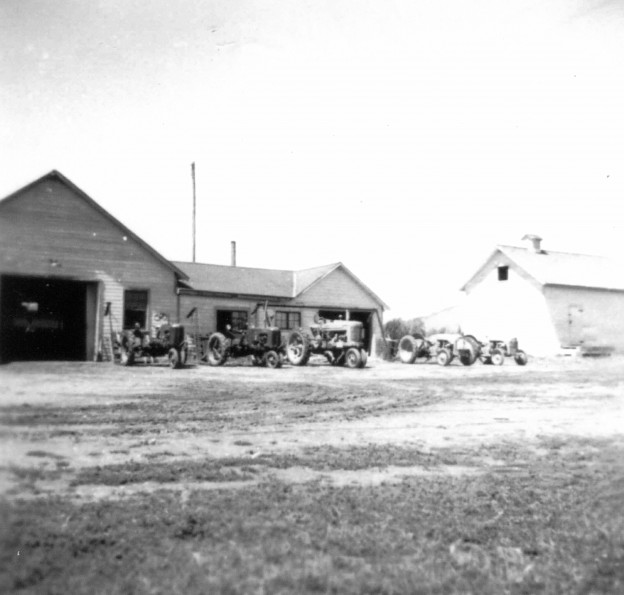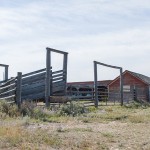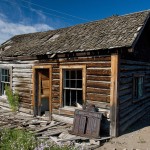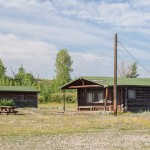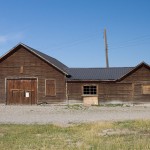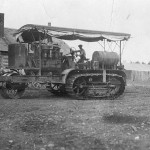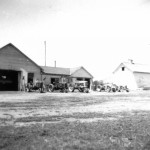- Barns and storage buildings at the Elk Ranch. Photo by Samantha Ford
- Corrals at the Elk Ranch. Photo by Samantha Ford
- Cabin at the Elk Ranch. Photo by Samantha Ford
- Cabins at the Elk Ranch. Photo by Samantha Ford
- Storage buildings at the Elk Ranch. Photo by Samantha Ford
- First caterpillar in Jackson Hole. From the collection of the Jackson Hole Historical Society and Museum
- The Elk Ranch. From the collection of the Jackson Hole Historical Society and Museum
- The Elk Ranch. From the collection of the Jackson Hole Historical Society and Museum
Josiah David “Si” Ferrin first arrived in Jackson Hole in 1900 from Ogden Valley, Utah. He had been in the valley previously, during work as a cattle driver. His work took him through most of western Wyoming, but Jackson Hole had made an impression. He settled on land near Twin Creek on today’s Elk Refuge. Despite doing all the necessary work to receive the patent on his homestead, he kept an eye on the events in the northern portion of the valley. Si desperately wanted to ranch on the land near the Buffalo Fork, where the soil and water resources could support a large cattle ranch. In 1908 he heard the good news that the land was opened for homesteading, and immediately upon receiving the patent for his Twin Creek homestead, sold it and moved to the Buffalo Valley. President Roosevelt had signed an executive order Here he staked his claim and began work to prove up on the new parcel of land, receiving his patent in 1913. Meanwhile, Ferrin’s neighbors were equally hard at work. Otto Kusche filed on the land that would later become the Elk Ranch. He cleared 13 acres, planted alfalfa, built a house, barn, and storeroom. Most importantly, he dug the O.K. Ditch to irrigate his lands. Nearby, Ferrin had already begun to purchase adjacent homesteads, starting with the acquisition of the Thompson homestead in 1911.
In 1912, D.E. Skinner arrived in Jackson Hole on a hunting expedition. Like Ferrin, Skinner also realized that the Buffalo Valley has excellent land for cattle ranching; he resolved to return. In 1916 Skinner came back and purchased the Otto Kusche homestead, the same year that Kusche received his patent. Over the next decade, Skinner and Ferrin bought up the majority of the homesteads in the Buffalo Valley. Ferrin became incredibly successful after signing a contract with the Reclamation Service at Moran to supply them with beef for the dam workers at Jackson Lake. In addition to that contract, he provided a freighting service for the Reclamation service, and opened up a saw mill on his ranch. Out-performed, Skinner sold his Elk Ranch to Ferrin in 1920. By 1928, the Ferrin family owned an impressive total of 3,629.09 acres. They ran over 2,000 head of cattle, and Si Ferrin became known as “the cattle baron of Jackson Hole.”
Si had almost 14 children by two different wives, and 9 of them were sons. He had no lack of help on the ranch, his sons ran the freighting and saw mill ventures on the side. As the largest landowner in Jackson Hole, Ferrin became increasingly worried about development – as did many of his neighbors. In 1927 he sat down with neighbors J. Pierce Cunningham and Struthers Burt to write a petition in support of asking a federal agency to protect the land. Those that signed the petition were concerned that without the federal government’s protection, the valley would fall into the hands of commercial development and their ability to ranch and raise cattle would be severely curtailed. Cunningham and Burt were of the opinion that the valley was better suited for recreation rather than cattle ranching. They persuaded 97 of the valley residents to sign the document. By the end of 1927, the Snake River Land Company was formed with the silent backing of John D. Rockefeller Jr. The Company was formed separately from the petition, and the valley residents were not included in the plans.
When the Snake River Land Company began buying up parcels of land throughout Jackson Hole, rumors spread about the intentions for the land. Forced to explain their purpose, Rockefeller was revealed to be the backer and their plans for donation to the National Park Service became public. Despite the intention being equal with that of the petition, the locals were incensed that they were not part of the process. Despite the political turmoil that ensued, Ferrin wanted to support the cause and sold all of his holdings in 1928. In return he received $114,662.12 for all 3,629.09 acres. He moved his family into the town of Jackson and invested in a feedlot in Idaho. In a few short months, he was bankrupt due to the crash of the market and Great Depression. Needing funds, Ferrin found a job with Ben Goe at the Cowboy Bar. He was the night watchman and famously shot at his own reflection in the bar mirror, thinking it was an intruder. He is remembered for his work in building up the highly successful Elk Ranch, rather than the struggles he encountered later in life. Ferrin is reported to be the first to introduce oats and white-faced cattle into Jackson Hole.
After the Snake River Land Company purchased the Elk Ranch, they recognized the financial benefits of keeping the ranch intact and working. The ranch was also located on the eastern side of the valley, and therefore did not block any scenic views of the Tetons. The 1930-1940s the company transitioned to become the Jackson Hole Preserve, Inc. and leased the property out to continue raising cattle to supply World War II needs. The Preserve improved the ranch infrastructure, constructing the Uhl Reservoir to allow a constant source of water for the hay fields. Without continued use, the water rights would be taken away due to state regulations. Hay continued to be raised on the property and was used to supply the nearby National Elk Refuge with winter feed. During this time the Preserve also recognized that it was important to keep the “western character” of the valley alive. Tourists were allowed to visit the Elk Ranch to view operations in an effort to demonstrate the importance of cattle ranching on the early valley settlement economy.
In 1950 when the property transferred to the National Park Service, which continued to maintain the hayfields and winter their horses on the ranch. An exception to the rule, this meant that the park honored the grazing permits that had been in use for the last 25 years. The Elk Ranch also served the National Park Service by supplying meat and dairy for the various lodges in Grand Teton National Park. Overtime, however, the grazing permits ran out, with one permit remaining as of 2010. Today, many of the Elk Ranch buildings still stand on the property, mostly used as storage.
TIMELINE
1900: Josiah David “Si” Ferrin settled his homestead on Twin Creek near the town of Jackson.
1908: Ferrin receives the patent for his Twin Creek homestead. He sells the land when he hears that the Buffalo Valley is finally open for homesteading and rushes to stake his own claim. Successful, he names his new property the JF Ranch and begins work to receive a patent for his land.
1909: Otto Kusche files for a claim on the present-day Elk Ranch land. He clears 13 acres, plants alfalfa and digs the O.K. ditch for irrigation. He builds a house, barn, storeroom, and cellar. None of the Kusche buildings exist today.
1911: Si Ferrin purchases the Thompson homestead.
1912: D.E. Skinner arrives in Jackson Hole to hunt. He was guided by Jim Budge and realized the valley would be an excellent location for a cattle ranch.
1913: Ferrin receives a patent for his new homestead in the Buffalo Valley.
1914: Si Ferrin signs a contract with the Reclamation Service to provide beef for the Jackson Lake Dam workers. This lucrative deal would bring in a lot of cash that Ferrin would use to increase his holdings for a large cattle ranch. In addition to the Reclamation Service contract, Ferrin also provides freighting and saw mill services to the valley. This same year he purchases Joe Heniger’s homestead.
1916: Otto Kusche receives the patent for his ranch and sells it to Skinner later that year. The property is named the Elk Ranch by Skinner.
1917: Skinner forms a partnership with Val Allen and buys his land.
1918: Si Ferrin purchases the Marius Kristensen homestead.
1919: Skinner purchases the 750 acre Hatchet Ranch, owned by Jack Shive. He has 2,000
cattle on the ranch.
1920: Si Ferrin purchases the Elk Ranch from D.E. Skinner, who keeps the Hatchet Ranch. This year Ferrin earns himself the nickname “the cattle baron of Jackson Hole.”
1927: Ferrin purchases the McInelly’s 520 acres (his second wife’s family ranch).
1928: Ferrin purchases the Thornton homestead. The family now holds 3,629.09 acres total.
1928-1929: Ferrin sells his 1,708.74 acres to the Snake River Land Company, and his sons sold their acreage as well. The SRLC paid $114,662.12 for the lot.
Ray Ferrin: 643.57 acres
Leonard Ferrin: 640 acres
Ferrin Family: 640 acres
1929: Ferrin invests in a feedlot in Idaho. In a few short months he becomes bankrupt in the stock market crash and following Depression.
1930-1940: The Elk Ranch continues to raise hay, and was managed by the Snake River Land Company.
1940s: The Jackson Hole Preserve Inc. leases the property to renew cattle ranching for the WWII effort.
1943: The property becomes part of the Jackson Hole National Monument.
1950: The property becomes part of Grand Teton National Park. Some of the Elk Ranch structures still remain.
2015: NPS still leases out the Elk Ranch land for grazing in the summer months.
Text by Samantha Ford, Director of Historical Research and Outreach



